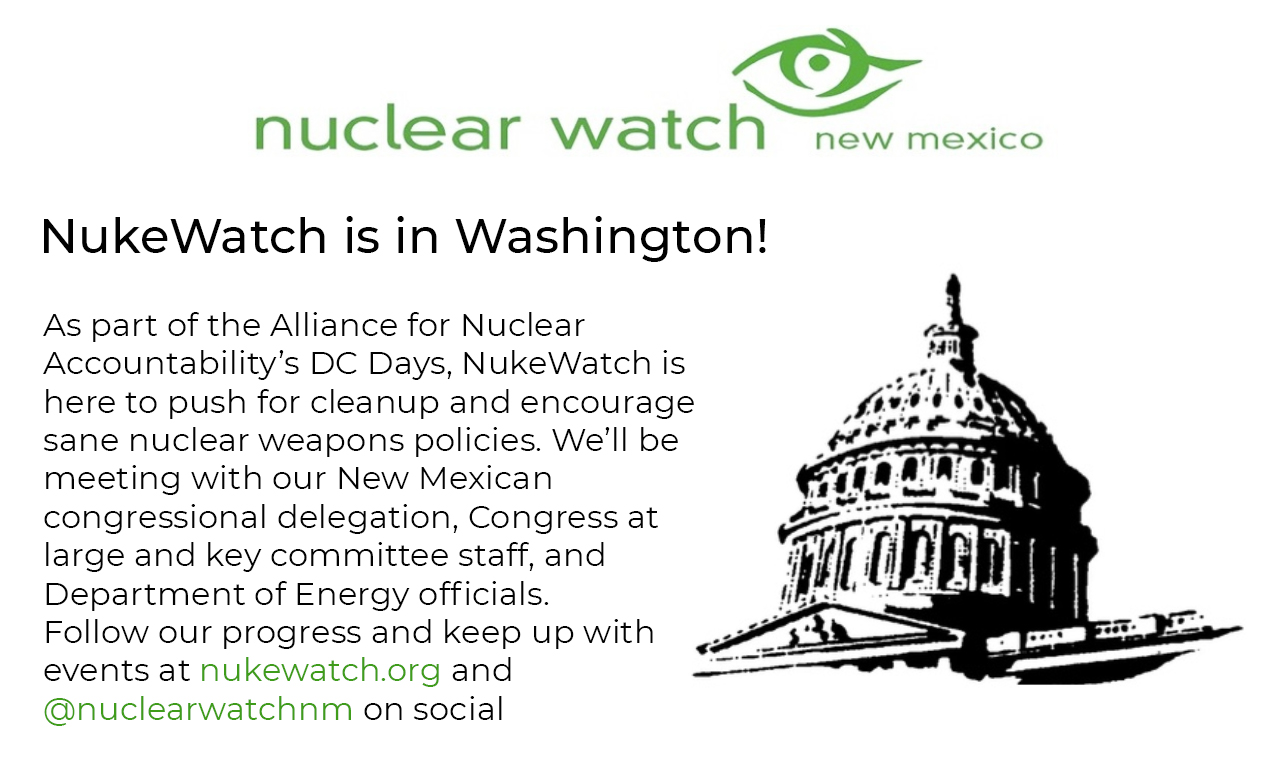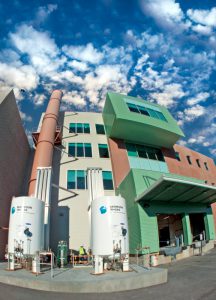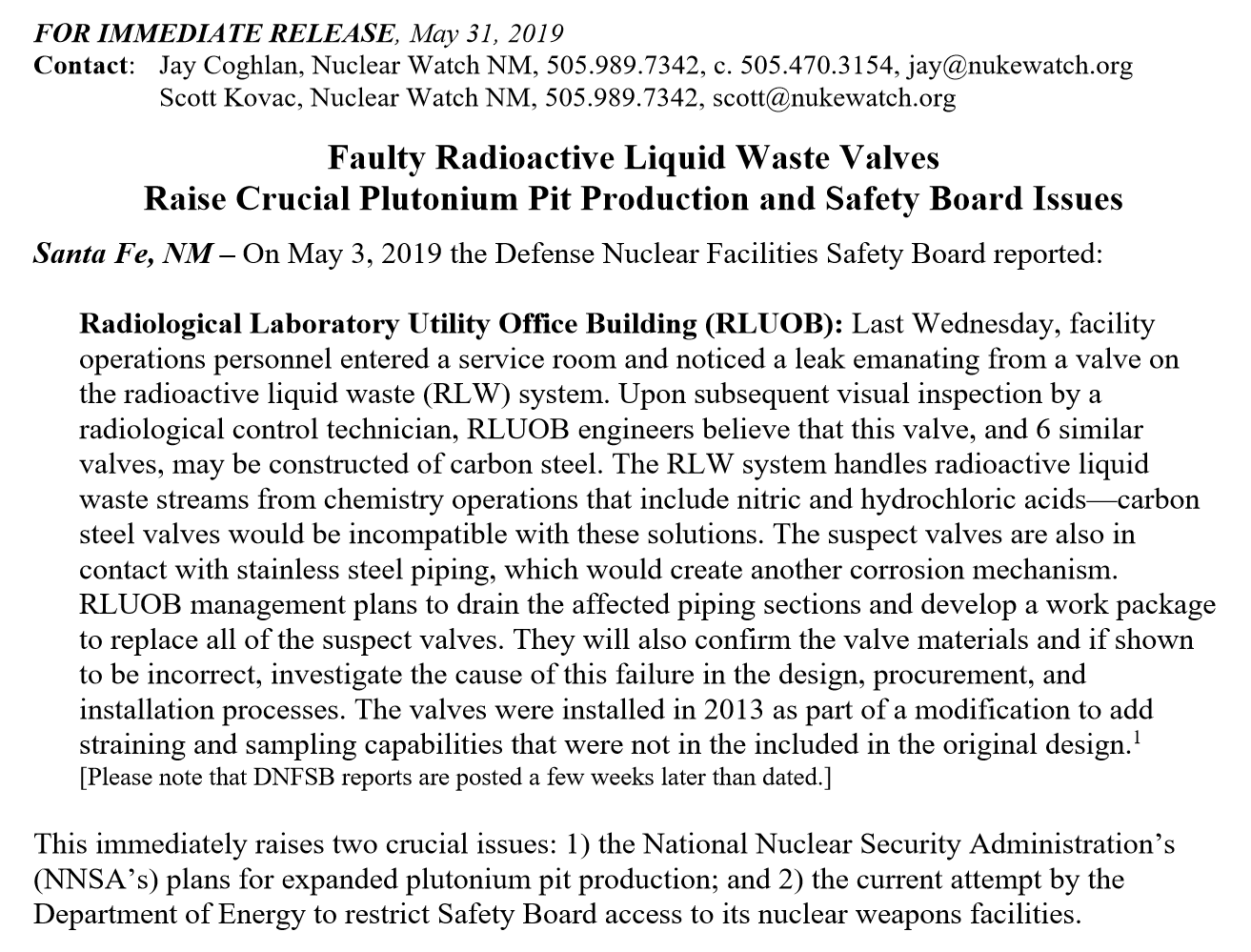2020
Nothing Found
It seems we can’t find what you’re looking for. Perhaps searching can help.
2019
Billion-dollar LANL building has plumbing problem
BY MARK OSWALD / JOURNAL STAFF WRITER
Saturday, June 1st, 2019 at 12:05am Copyright © 2019 Albuquerque Journal
SANTA FE – A building at Los Alamos National Laboratory with a price pegged at more than $1 billion apparently has some bad plumbing.
A federal safety oversight board recently reported that the operations staff at the Radiological Laboratory Utility Office Building found a leak in the building’s radioactive liquid waste system.
…
Jay Coghlan of Nuclear Watch New Mexico, a frequent LANL critic who called attention to the recent safety board report, said the plumbing problem is symptomatic of the lab’s history of safety issues, which has included using the wrong kind of cat litter as a desiccant when packing a radioactive waste drum. A reaction in the drum caused it to breach in 2014 and contaminate the nation’s nuclear waste storage facility near Carlsbad.
30th Anniversary of Tiananmen Square
Thirty years ago, Beijing’s Tiananmen Square became the focus for large-scale protests, which were crushed by China’s Communist rulers.
In the 1980s, China was going through huge changes. The ruling Communist Party began to allow some private companies and foreign investment. Leader Deng Xiaoping hoped to boost the economy and raise living standards. However, the move brought with it corruption, while at the same time raising hopes for greater political openness. The Communist Party was divided between those urging more rapid change and hardliners wanting to maintain strict state control. In the mid-1980s, student-led protests started, and in spring 1989, the protests grew, with demands for greater political freedom. On June 4, 1989, Chinese troops were sent to crush pro-democracy student protests in the famous square in central Beijing, leaving at least hundreds—and possibly thousands—of people dead.
The casualties included soldiers, but were overwhelmingly unarmed demonstrators who had been protesting in the square for six weeks, turning the site into the hub for protests in 400 other cities nationwide. Millions of people took part in the demonstrations, with more than 1 million people descending on Tiananmen Square.
As part of an ongoing brutal crackdown of internal dissent, Chinese authorities have carried out a harsh policy of history suppression, forbidding on-line or other discussions of the events at Tiananmen Square. In light of that it is worth recalling what U.S. government officials learned at the time and how they assessed Beijing’s response to internal dissent.
To mark an event that decisively shaped contemporary China, the National Security Archive is republishing three documentary E-books that appeared on previous anniversaries, in 1999, 2001, and 2015. The declassified documents demonstrate that U.S. embassy officials realized very quickly that the Chinese military had carried out a massacre ordered by top officials who feared the public expression of dissent could threaten Communist Party rule. VIEW HERE
Billion-dollar LANL building has plumbing problem
JUNE 1, 2019 | BY MARK OSWALD | abqjournal.com
Copyright © 2019 Albuquerque Journal
SANTA FE – A building at Los Alamos National Laboratory with a price pegged at more than $1 billion apparently has some bad plumbing.
A federal safety oversight board recently reported that the operations staff at the Radiological Laboratory Utility Office Building found a leak in the building’s radioactive liquid waste system.
Lab watchdogs have labeled RLUOB, which got the green light for construction in 2011, as the most expensive building in New Mexico. The lab’s website says it’s part of a capital project to replace aging Cold War-era facilities.
Jay Coghlan of Nuclear Watch New Mexico, a frequent LANL critic who called attention to the recent safety board report, said the plumbing problem is symptomatic of the lab’s history of safety issues, which has included using the wrong kind of cat litter as a desiccant when packing a radioactive waste drum. A reaction in the drum caused it to breach in 2014 and contaminate the nation’s nuclear waste storage facility near Carlsbad.
“Remember, this is the gang that couldn’t get it straight between organic and inorganic cat litter, sending a radioactive waste drum that ruptured and closed the Waste Isolation Pilot Plant for three years, costing the American taxpayer three billion dollars to reopen,” Coghlan said in a statement. “Now we learn that they don’t know elementary plumbing for liquid radioactive wastes lines, and we’re supposed to trust them while they unjustifiably expand plutonium pit production?”
LANL is in the process of ramping up for a congressional mandate to the National Nuclear Security Administration, which oversees the nation’s weapons complex, for production of “pits,” the plutonium cores of nuclear weapons as part of a huge plan to modernize the nation’s nuclear arsenal.
Faulty Radioactive Liquid Waste Valves Raise Crucial Plutonium Pit Production and Safety Board Issues

There should be no expanded pit production until nuclear safety is fully assured by an independent, unrestricted Safety Board, and our congressional delegation should be the first to demand that.
Atomic Veterans Were Silenced for 50 Years. Now, They’re Talking.
Nearly everyone who’s seen it and lived to tell the tale describes it the same way: a horrifying, otherworldly thing of ghastly beauty that has haunted their life ever since.
VIDEO BY MORGAN KNIBBE | theatlantic.com
“The colors were beautiful,” remembers a man in Morgan Knibbe’s short documentary The Atomic Soldiers. “I hate to say that.”
“It was completely daylight at midnight—brighter than the brightest day you ever saw,” says another.
Many tales of the atomic bomb, however, weren’t told at all. In addition to the hundreds of thousands of Japanese civilians who died in Hiroshima and Nagasaki, an estimated 400,000 American soldiers and sailors also observed nuclear explosions—many just a mile or two from ground zero. From 1946 to 1992, the U.S. government conducted more than 1,000 nuclear tests, during which unwitting troops were exposed to vast amounts of ionizing radiation. For protection, they wore utility jackets, helmets, and gas masks. They were told to cover their face with their arms.
After the tests, the soldiers, many of whom were traumatized, were sworn to an oath of secrecy. Breaking it even to talk among themselves was considered treason, punishable by a $10,000 fine and 10 or more years in prison.
New START Must Be Extended, Without or Without China
The baffling non-answers from the senior administration officials strongly suggest that the president’s impulse for a grand U.S.-Chinese-Russian arms control bargain is not backed up with a realistic plan.
BY DARYL KIMBALL | nationalinterest.org
On May 14, Secretary of State Mike Pompeo traveled to Sochi, Russia to discuss what the State Department called a “new era” in “arms control to address new and emerging threats” with Russian foreign minister Sergey Lavrov and President Vladimir Putin.
The trip follows reports that Donald Trump has directed his administration to seek a new arms control agreement with Russia and China that should include: “all the weapons, all the warheads, and all the missiles.”
U.S. officials, including National Security Advisor John Bolton, have criticized the 2010 New Strategic Arms Reduction Treaty (New START) because it only limits U.S. and Russian deployed strategic nuclear weapons and does not cover Russia’s stockpile of sub-strategic warheads in central storage inside Russia.
New START, which caps each side’s enormous and devastating long-range nuclear weapons to no more than 1,550 deployed warheads and 700 deployed strategic missiles and bombers, will expire in February 2021 if Trump and Putin don’t agree to an extension.
Continue reading
Trump Prepared to Bypass Congress on Saudi Arms Sale: Senators
Democrats warn Trump may use ’emergency’ loophole to sell missiles to Saudi Arabia without congressional approval.
WILLIAM ROBERTS | aljazeera.com
Washington, DC – Democrats in the United States Senate have warned that the Trump administration is preparing to approve a major new arms sale to Saudi Arabia, using an “emergency” loophole to bypass Congress.
“I am expecting that the administration is going to notice a major arms sale through emergency powers,” Senator Chris Murphy, a Democrat, told Al Jazeera on Thursday, after he said an administration official gave the Senate Foreign Relations Committee “informal notice” of the forthcoming announcement.
US arms control law allows Congress to reject weapons sales to foreign countries but an exemption in the law allows the president to waive the need for congressional approval by declaring a national security emergency.
 Last week, Nuclear Watch New Mexico was in Washington participating in the Alliance for Nuclear Accountability’s 31st annual DC Days. As a recent addition to the NukeWatch NM staff, this was my first time attending DC Days. The week consisted of a Sunday training day followed by three days straight of lobbying meetings with congress and other government departments that have a huge say in new nuclear weapons or energy developments. When the meeting days concluded, I also attended ANA’s Spring Meeting, which is a two-day debriefing and planning session to discuss thoughts on the week and new plans for the year ahead. This week was not only informative but enlightening, in terms of how I learned the ins-and outs of congress and the true functioning (or lack thereof, occasionally) of government. A large part of why I learned as much as I did and why I did feel so engaged, was due to being surrounded by the most genuine and helpful set of people. I would not have felt as comfortable in this world of politics (which is completely foreign to me) if it was not for the other members of ANA organizations that treated me as an equal contributor, despite my lack of knowledge in certain areas. This is a brief introduction to my time in DC, but there are more technical issues to discuss! A following post will contain the specific details of the issues ANA, and NukeWatch specifically, tackled during the week, including: Lobbying for No New Bomb Plants, Reducing proposed plutonium pit production, fighting Yucca mountain & consolidated interim storage – proposing alternatives to these, supporting a No First Use Policy, and much, much more.
Last week, Nuclear Watch New Mexico was in Washington participating in the Alliance for Nuclear Accountability’s 31st annual DC Days. As a recent addition to the NukeWatch NM staff, this was my first time attending DC Days. The week consisted of a Sunday training day followed by three days straight of lobbying meetings with congress and other government departments that have a huge say in new nuclear weapons or energy developments. When the meeting days concluded, I also attended ANA’s Spring Meeting, which is a two-day debriefing and planning session to discuss thoughts on the week and new plans for the year ahead. This week was not only informative but enlightening, in terms of how I learned the ins-and outs of congress and the true functioning (or lack thereof, occasionally) of government. A large part of why I learned as much as I did and why I did feel so engaged, was due to being surrounded by the most genuine and helpful set of people. I would not have felt as comfortable in this world of politics (which is completely foreign to me) if it was not for the other members of ANA organizations that treated me as an equal contributor, despite my lack of knowledge in certain areas. This is a brief introduction to my time in DC, but there are more technical issues to discuss! A following post will contain the specific details of the issues ANA, and NukeWatch specifically, tackled during the week, including: Lobbying for No New Bomb Plants, Reducing proposed plutonium pit production, fighting Yucca mountain & consolidated interim storage – proposing alternatives to these, supporting a No First Use Policy, and much, much more.
2018
Nothing Found
It seems we can’t find what you’re looking for. Perhaps searching can help.
2017
Nothing Found
It seems we can’t find what you’re looking for. Perhaps searching can help.
2016
Nothing Found
It seems we can’t find what you’re looking for. Perhaps searching can help.
2015
Nothing Found
It seems we can’t find what you’re looking for. Perhaps searching can help.




